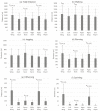Time-Motion Analysis by Playing Positions of Male Handball Players during the European Championship 2020
- PMID: 33801814
- PMCID: PMC8002104
- DOI: 10.3390/ijerph18062787
Time-Motion Analysis by Playing Positions of Male Handball Players during the European Championship 2020
Abstract
The aim of this study was to analyze time-motion characteristics of elite male handball players during the last European Championship 2020. A total of 414 players from 24 national teams were analyzed during 65 matches using a local positioning system (LPS) for the first time in a European Championship. Players (n = 1865) covered significantly (p < 0.001; ES = 0.48) more total distance in offense (1217.48 ± 699.33 m) and in all locomotion categories (p < 0.001) than in defense (900.96 ± 538.95 m), with a similar average total time on court (13.40 ± 8.19 min in offense and 13.27 ± 8.59 min; p > 0.05). The running pace was significantly higher in offense 96.53 ± 22.57 m/min than in defense 82.72 ± 43.28 m/min (p < 0.001; ES = 0.47). By playing positions, the Left Wing players covered significantly (p < 0.001) higher distances (2547.14 ± 1309.52) and showed longer playing time (32.08 ± 17.01). Center Back was the playing position that showed the highest global running pace (98.34 m/min). Players with higher running pace in offense (p < 0.001) were Left Backs (105.95 ± 25.20) and the Center Backs in defense (95.76 ± 48.90). There were no significant differences between winners and losers or between top ranked and lower ranked teams in terms of time played, distance covered, and running pace. Specific physical conditioning is necessary to maximize performance and minimize fatigue when performing in long tournaments.
Keywords: LPS; covered distance; load monitoring; performance analysis; running pace.
Conflict of interest statement
The authors declare no conflict of interest.
Figures




References
-
- Marczinka Z. Playing Handball. A Comprehensive Study of the Game. Kék Európa Stúdió Publishing House; Budapest, Hungary: 2016.
-
- International Handball Federation . The Rules of the Game. International Handball Federation; Basle, Switzerland: 2016.
-
- Marczinka Z., Gál A. The chain reaction between the media and sport. the impact of rule changes in Handball. Phys. Cult. Sport Stud. Res. 2018;80:39–47. doi: 10.2478/pcssr-2018-0024. - DOI
-
- Manchado C., Hoffmann E., Valdivielso F.N., Platen P. Physiological demands in female handball—Demands and heart rate during matches of the German National Team. Dtsch. Z. Sportmed. 2007;58:368–373.
Publication types
MeSH terms
LinkOut - more resources
Full Text Sources
Other Literature Sources

